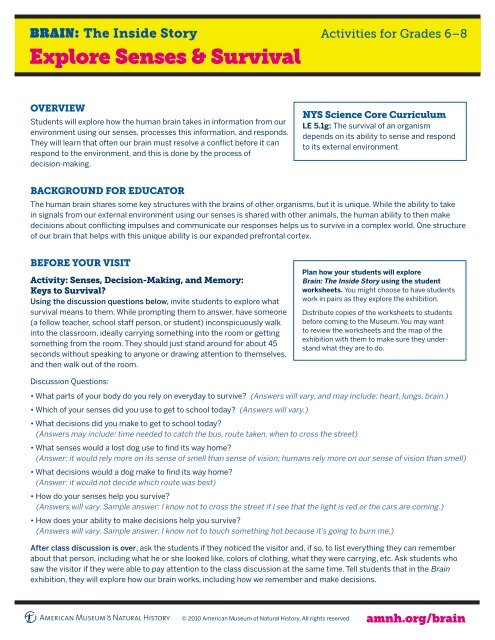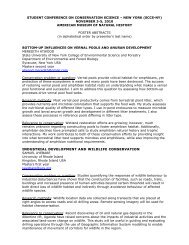Brain: The Inside Story: Activities for Grades 6-8 - American Museum ...
Brain: The Inside Story: Activities for Grades 6-8 - American Museum ...
Brain: The Inside Story: Activities for Grades 6-8 - American Museum ...
Create successful ePaper yourself
Turn your PDF publications into a flip-book with our unique Google optimized e-Paper software.
BRAIN: <strong>The</strong> <strong>Inside</strong> <strong>Story</strong> <strong>Activities</strong> <strong>for</strong> <strong>Grades</strong> 6–8Explore Senses & SurvivalOVERVIEWStudents will explore how the human brain takes in in<strong>for</strong>mation from ourenvironment using our senses, processes this in<strong>for</strong>mation, and responds.<strong>The</strong>y will learn that often our brain must resolve a conflict be<strong>for</strong>e it canrespond to the environment, and this is done by the process ofdecision-making.NYS Science Core CurriculumLE 5.1g: <strong>The</strong> survival of an organismdepends on its ability to sense and respondto its external environment.BACKGROUND FOR EDUCATOR<strong>The</strong> human brain shares some key structures with the brains of other organisms, but it is unique. While the ability to takein signals from our external environment using our senses is shared with other animals, the human ability to then makedecisions about conflicting impulses and communicate our responses helps us to survive in a complex world. One structureof our brain that helps with this unique ability is our expanded prefrontal cortex.BEFORE YOUR VISITActivity: Senses, Decision-Making, and Memory:Keys to Survival?Using the discussion questions below, invite students to explore whatsurvival means to them. While prompting them to answer, have someone(a fellow teacher, school staff person, or student) inconspicuously walkinto the classroom, ideally carrying something into the room or gettingsomething from the room. <strong>The</strong>y should just stand around <strong>for</strong> about 45seconds without speaking to anyone or drawing attention to themselves,and then walk out of the room.Plan how your students will explore<strong>Brain</strong>: <strong>The</strong> <strong>Inside</strong> <strong>Story</strong> using the studentworksheets. You might choose to have studentswork in pairs as they explore the exhibition.Distribute copies of the worksheets to studentsbe<strong>for</strong>e coming to the <strong>Museum</strong>. You may wantto review the worksheets and the map of theexhibition with them to make sure they understandwhat they are to do.Discussion Questions:• What parts of your body do you rely on everyday to survive? (Answers will vary, and may include: heart, lungs, brain.)• Which of your senses did you use to get to school today? (Answers will vary.)• What decisions did you make to get to school today?(Answers may include: time needed to catch the bus, route taken, when to cross the street)• What senses would a lost dog use to find its way home?(Answer: it would rely more on its sense of smell than sense of vision; humans rely more on our sense of vision than smell)• What decisions would a dog make to find its way home?(Answer: it would not decide which route was best)• How do your senses help you survive?(Answers will vary. Sample answer: I know not to cross the street if I see that the light is red or the cars are coming.)• How does your ability to make decisions help you survive?(Answers will vary. Sample answer: I know not to touch something hot because it’s going to burn me.)After class discussion is over, ask the students if they noticed the visitor and, if so, to list everything they can rememberabout that person, including what he or she looked like, colors of clothing, what they were carrying, etc. Ask students whosaw the visitor if they were able to pay attention to the class discussion at the same time. Tell students that in the <strong>Brain</strong>exhibition, they will explore how our brain works, including how we remember and make decisions.© 2010 <strong>American</strong> <strong>Museum</strong> of Natural History. All rights reserved.amnh.org/brain
BRAIN: <strong>The</strong> <strong>Inside</strong> <strong>Story</strong> <strong>Activities</strong> <strong>for</strong> <strong>Grades</strong> 6–8DURING YOUR VISIT<strong>Brain</strong>: <strong>The</strong> <strong>Inside</strong> <strong>Story</strong> Exhibition3rd floor (45 minutes)Have students use their student worksheets to investigate brain anatomy and how our brain responds to our environment.You might choose to have students work in pairs as they explore the exhibition. In the Your Emotional <strong>Brain</strong> section,students will build a 3-D model of a human brain by assembling the different parts shared between reptiles, mammals,primates, and humans. <strong>The</strong>n they will compare and contrast the brains of different species. In the Your Thinking <strong>Brain</strong>section, they will time each other at the word-color test to determine how fast they can reconcile conflicting impulses.<strong>The</strong> next interactive they will visit is number chunking, where they will need to organize in<strong>for</strong>mation to recall as manynumbers as possible.Spitzer Hall of Human Origins1st Floor (20–30 minutes)Go to the middle of the exhibition and find the four dioramas that depict the lives of our early human ancestors: A New Typeof Human, Hyenas vs. Hominids, Neanderthal Campsite, and Life During the Ice Age. Have students work in small groupsand select two dioramas to compare and contrast how hominids (early humans) survived in their environments. Havestudents gather evidence from each scene to answer the following questions:• How would you describe the environment?(Sample answer: In the ice age diorama, it’s snowy and cold.)• What senses are the early humans using in their environments?(Sample answer: <strong>The</strong>y might be listening to the environment, looking out <strong>for</strong> prey, looking at each other <strong>for</strong> bodylanguage, and using sense of touch to make sharp things <strong>for</strong> defense.)• What decisions are they making in order to survive in their environment?(Sample answer: <strong>The</strong> people are wearing fur, using fire, using tools, living in shelter, and working together.)BACK IN THE CLASSROOMClass Discussion: Making Sense of Your SensesDivide the class into groups of four. Have each group review their worksheets and discuss the following questions. <strong>The</strong>n askeach group to share their findings with other groups.1. Build a <strong>Brain</strong> & Evolving Emotions• Looking at the chart you completed, do you think a lizard, dog, or monkey could play the word-color or chunking numbersgames? Why or why not?(Answer: No, because only humans have a prefrontal cortex. This brain part helps us make plans, predictions,and decisions.)2. Chunking Numbers• What decisions did you have to make to group the numbers?(Answers will vary, and may include: I grouped the numbers into several “chunks.” I thought of 2011 as a year, which iseasy to remember.)3. Word-Color Test• Was it harder to say the color of the words in Column A, or Column B? Why?(Answer: Column B was harder because the color of the words did not match the meaning of the words. When the wordsand colors conflict, the brain must struggle to ignore competing in<strong>for</strong>mation.)© 2010 <strong>American</strong> <strong>Museum</strong> of Natural History. All rights reserved.amnh.org/brain
BRAIN: <strong>The</strong> <strong>Inside</strong> <strong>Story</strong> <strong>Activities</strong> <strong>for</strong> <strong>Grades</strong> 6–8ONLINE RESOURCES<strong>Brain</strong> OLogyamnh.org/ology/brainHands-on activities and online games help students explore how the brain senses and responds the world around us.<strong>The</strong>y can do the word-color test again in “Trip Up Your <strong>Brain</strong>.”ScienceBulletins: New <strong>Brain</strong> Model of Earliest Primatesciencebulletins.amnh.org/?sid=h.s.memory.20090126Researchers from the universities of Florida and Winnipeg have reconstructed the brain of Ignacius graybullianus, one ofthe earliest primates known, from a 54-million-year-old fossil skull. It’s the most complete brain model of its kind and castsnew light on the beginnings of primate brain development.ScienceBulletins: When Young <strong>Brain</strong>s Become Socialsciencebulletins.amnh.org/?sid=h.s.young_brain.20090713A brain imaging study from MIT and Yale reveals the neural regions underlying social cognition—the ability to recognizeother people’s thoughts and feelings—in children aged 6 to 11.© 2010 <strong>American</strong> <strong>Museum</strong> of Natural History. All rights reserved.amnh.org/brain
BRAIN: <strong>The</strong> <strong>Inside</strong> <strong>Story</strong>STUDENT WORKSHEET<strong>Grades</strong> 6–8EXPLORE WHAT MAKES US HUMAN1Build a <strong>Brain</strong>In the Your Emotional <strong>Brain</strong> section, go to the 3-D model of a human brain and assemble it. Write thename of the brain part in the boxes. <strong>The</strong>n, draw a line to match the brain part with what it does.121.2.Produces emotionsand memoriesProcesses sensesand thoughts33.Produces basic movementsand motivations44.Helps humans plan aheadand make decisions2Evolving EmotionsTo the left of Build a <strong>Brain</strong>, look <strong>for</strong> the wall that displays the brains of a sea snail (mollusk), an iguana(reptile), a raccoon (non-primate mammal), a macaque monkey (non-human primate), and a human.Working with a partner, compare and contrast the illustrations of different animal brains. <strong>The</strong>ncomplete the chart below by indicating the presence (yes) or absence (no) of different partsof the brain in each of the organisms.Do these organismshave …..?(Complete with yes or no)SeaSnailIguanaRaccoonRhesusMonkeyHumanBRAIN STEM and CEREBELLUMLIMBIC SYSTEMCORTEXPREFRONTAL CORTEX© 2010 <strong>American</strong> <strong>Museum</strong> of Natural History. All rights reserved.amnh.org/brain
BRAIN: <strong>The</strong> <strong>Inside</strong> <strong>Story</strong> <strong>Grades</strong> 6–83Chunk <strong>The</strong>se NumbersNext, go to the Your Thinking <strong>Brain</strong> section and find the area titled “Short-Term Memory.” Group thenumbers in such a way that you can remember as many as possible. How did you organize them?Copy the chunks or groups of numbers that helped you remember the most numbers at once.4Don’t Read <strong>The</strong>se WordsIn the same section, look <strong>for</strong> the display with a clock. Working with your partner, time each other to seehow long it takes to say the COLOR of the words out loud (don’t read the words!). Record your timeand your partner’s time.Try column A once, and column B three times to see if you get faster.NAMEColumn ATimeColumn BTime 1Column BTime 2Column BTime 3© 2010 <strong>American</strong> <strong>Museum</strong> of Natural History. All rights reserved.amnh.org/brain
BRAIN: <strong>The</strong> <strong>Inside</strong> <strong>Story</strong>STUDENT WORKSHEETEXPLORE WHAT MAKES US HUMAN<strong>Grades</strong> 6–8ANSWER KEY1Build a <strong>Brain</strong>In the Your Emotional <strong>Brain</strong> section, go to the 3-D model of a human brain and assemble it. Write thename of the brain part in the boxes. <strong>The</strong>n, draw a line to match the brain part with what it does.121.2.BRAIN STEM and CEREBELLUMLIMBIC SYSTEMProduces emotionsand memoriesProcesses sensesand thoughts33.CORTEXProduces basic movementsand motivations44.PREFRONTAL CORTEXHelps humans plan aheadand make decisions2Evolving EmotionsTo the left of Build a <strong>Brain</strong>, look <strong>for</strong> the wall that displays the brains of a sea snail (mollusk), an iguana(reptile), a raccoon (non-primate mammal), a macaque monkey (non-human primate), and a human.Working with a partner, compare and contrast the illustrations of different animal brains. <strong>The</strong>ncomplete the chart below by indicating the presence (yes) or absence (no) of different partsof the brain in each of the organisms.Do these organismshave …..?(Complete with yes or no)SeaSnailIguanaRaccoonRhesusMonkeyHumanBRAIN STEM and CEREBELLUMNoYesYesYesYesLIMBIC SYSTEMNoNoYesYesYesCORTEXNoNoNoYesYesPREFRONTAL CORTEXNoNoNoNoYes© 2010 <strong>American</strong> <strong>Museum</strong> of Natural History. All rights reserved.amnh.org/brain
BRAIN: <strong>The</strong> <strong>Inside</strong> <strong>Story</strong> <strong>Grades</strong> 6–83Chunk <strong>The</strong>se NumbersANSWER KEYNext, go to the Your Thinking <strong>Brain</strong> section and find the area titled “Short-Term Memory.” Group thenumbers in such a way that you can remember as many as possible. How did you organize them?Copy the chunks or groups of numbers that helped you remember the most numbers at once.(Answers will vary)4Don’t Read <strong>The</strong>se WordsIn the same section, look <strong>for</strong> the display with a clock. Working with your partner, time each other to seehow long it takes to say the COLOR of the words out loud (don’t read the words!). Record your timeand your partner’s time.Try column A once, and column B three times to see if you get faster.NAMEColumn ATimeColumn BTime 1Column BTime 2Column BTime 3(Answers will vary)© 2010 <strong>American</strong> <strong>Museum</strong> of Natural History. All rights reserved.amnh.org/brain
















